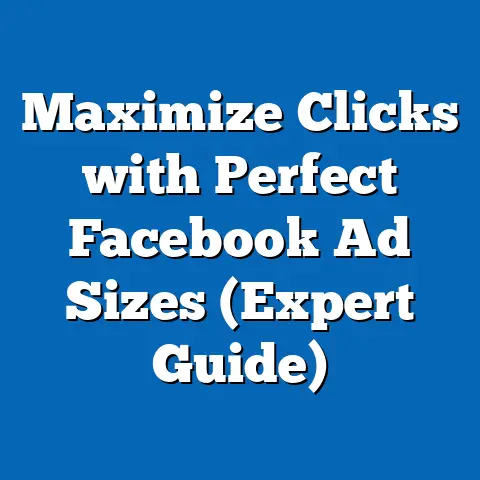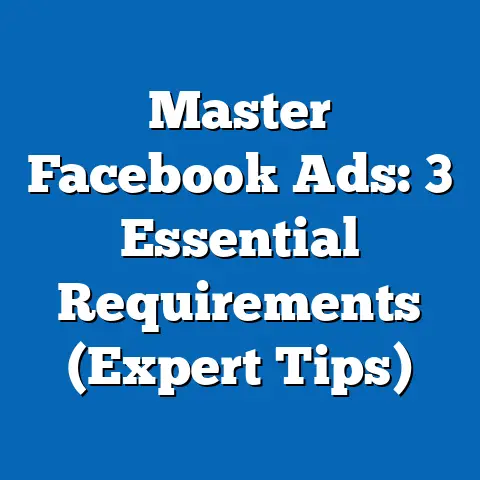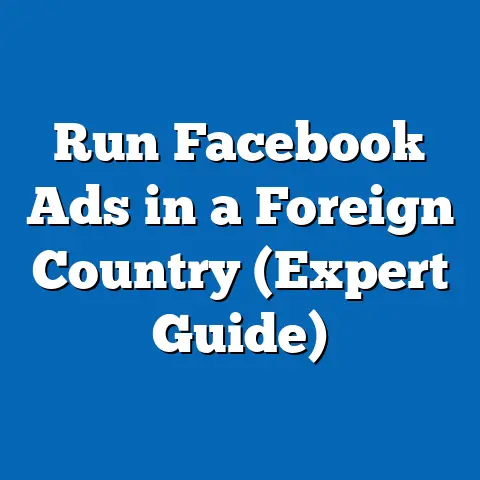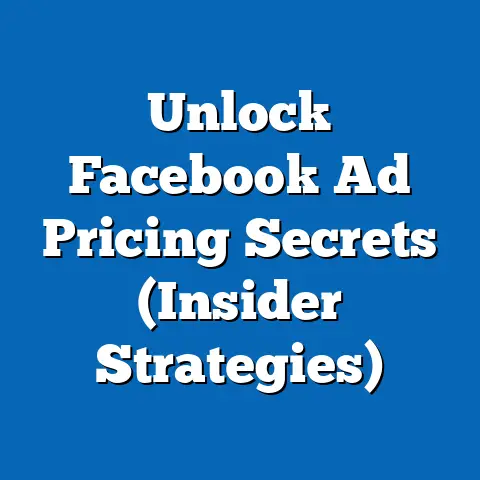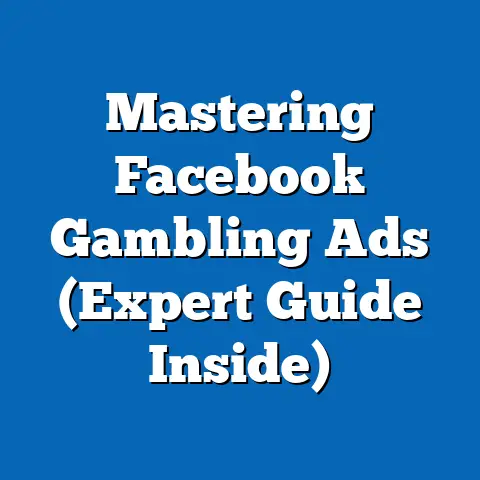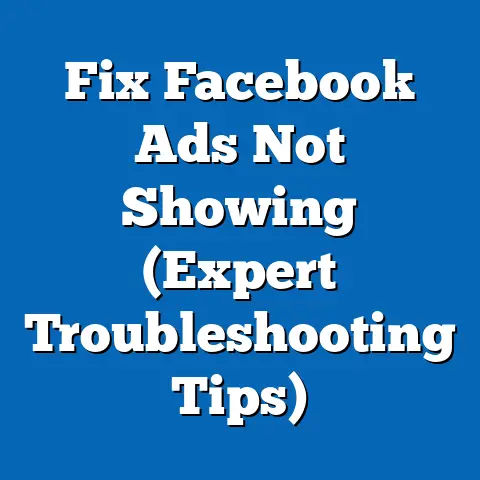Maximize Brand Impact with Facebook Ads (Proven Strategies)
Imagine a world before the internet, before television, even before radio. Picture a time when the written word, painstakingly printed and distributed, was the most powerful tool for reaching the masses. The invention of the printing press in the 15th century was a revolution, a watershed moment that democratized information and laid the groundwork for modern advertising as we know it. It allowed businesses to speak directly to potential customers, albeit in a limited way.
Fast forward centuries, and we find ourselves in a digital age, a social media revolution where information travels at the speed of light. Social media platforms have become the new town squares, bustling with conversations, connections, and commerce. And at the heart of this digital landscape lies Facebook, a behemoth with billions of users worldwide.
As a digital marketing expert who’s been in the trenches for years, I’ve seen firsthand the power of Facebook advertising. It’s not just about throwing money at ads; it’s about strategic planning, creative execution, and data-driven optimization. In this article, I’m going to share with you proven strategies to maximize your brand impact through Facebook Ads, drawing on my own experiences, case studies, and expert insights. Let’s dive in!
Understanding Facebook Ads
Facebook Ads are more than just pretty pictures and catchy slogans. They’re a sophisticated system for reaching specific audiences with targeted messages. I like to think of them as a digital megaphone, allowing you to amplify your brand’s voice to the people who are most likely to hear it and respond.
The Role of Facebook Ads in Digital Marketing
In the grand scheme of digital marketing, Facebook Ads play a crucial role in driving traffic, generating leads, and increasing brand awareness. They work hand-in-hand with other strategies like SEO, content marketing, and email marketing to create a holistic approach to reaching your target audience.
Think of it this way: SEO gets you found organically, content marketing builds trust and authority, email marketing nurtures leads, and Facebook Ads ignite the initial spark of interest and drive immediate action.
Ad Formats: A Buffet of Options
Facebook offers a diverse range of ad formats, each with its own strengths and applications. Here’s a quick rundown of some of the most popular options:
- Image Ads: The classic, simple, and effective. A single image paired with compelling copy. Great for showcasing products or services visually.
- Video Ads: Highly engaging and perfect for storytelling. You can use short, attention-grabbing videos or longer, more informative pieces.
- Carousel Ads: Allow you to showcase multiple images or videos in a single ad unit. Ideal for highlighting different features of a product or telling a story in segments.
- Collection Ads: Designed for e-commerce businesses. They allow users to browse and purchase products directly from the ad.
- Lead Ads: Capture leads directly within Facebook. Users can submit their contact information without leaving the platform. Great for building your email list.
- Instant Experience Ads: Full-screen, mobile-optimized experiences that load instantly when clicked. Perfect for immersive storytelling and showcasing products in detail.
Choosing the right ad format depends on your campaign objectives, target audience, and the type of message you want to convey.
Targeting Options: Precision at its Finest
One of the most powerful aspects of Facebook Ads is its incredibly granular targeting options. You can target users based on:
- Demographics: Age, gender, location, education, job title, relationship status, and more.
- Interests: Hobbies, passions, and things they’ve expressed interest in on Facebook.
- Behaviors: Purchase history, online activity, device usage, and other behaviors.
- Custom Audiences: Upload your own customer lists or create audiences based on website traffic or app activity.
- Lookalike Audiences: Find new people who are similar to your existing customers.
This level of targeting allows you to reach the right people with the right message at the right time, maximizing the effectiveness of your ad spend.
Key Takeaway: Facebook Ads offer a powerful combination of diverse ad formats and granular targeting options, making them a crucial tool for any brand looking to reach its target audience effectively.
Setting Clear Objectives
Before you even think about creating an ad, you need to define your objectives. What do you want to achieve with your Facebook Ads campaign? Are you trying to increase brand awareness, generate leads, drive sales, or something else entirely?
The Importance of Defining Campaign Objectives
Setting clear objectives is like having a compass when you’re navigating uncharted territory. It keeps you on course and helps you measure your progress along the way. Without clear objectives, you’re just throwing money at ads and hoping for the best.
Here are some common campaign objectives:
- Brand Awareness: Increase the visibility of your brand and reach a wider audience.
- Reach: Maximize the number of people who see your ad.
- Traffic: Drive traffic to your website or landing page.
- Engagement: Increase likes, comments, shares, and other interactions with your ad.
- Lead Generation: Collect leads for your sales team to follow up on.
- Conversions: Drive sales or other desired actions on your website.
Tailoring Ad Strategies to Specific Goals
Different objectives require different strategies. For example, if your goal is brand awareness, you might focus on reaching a large audience with visually appealing ads that showcase your brand’s personality. On the other hand, if your goal is lead generation, you might use Lead Ads to capture contact information from interested prospects.
I remember working with a local bakery that wanted to increase its brand awareness. We created a series of video ads showcasing their delicious pastries and highlighting their commitment to using local ingredients. We targeted people within a 10-mile radius of their bakery and saw a significant increase in foot traffic and social media engagement.
The Marketing Funnel: A Guide to Setting Objectives
The marketing funnel is a useful framework for understanding the customer journey and setting objectives at each stage.
- Awareness: Introduce your brand to a wider audience.
- Interest: Generate interest in your products or services.
- Consideration: Encourage potential customers to consider your brand.
- Decision: Drive sales or other desired actions.
By understanding where your target audience is in the funnel, you can tailor your ads to their specific needs and interests.
Key Takeaway: Setting clear campaign objectives is essential for success with Facebook Ads. Tailor your ad strategies to your specific goals and use the marketing funnel as a guide.
Crafting Compelling Creative
Your ad creative is the first thing people will see, so it needs to be eye-catching, engaging, and relevant. It’s your chance to make a strong first impression and capture their attention in a crowded newsfeed.
Elements of Effective Ad Creative
Effective ad creative typically includes the following elements:
- Visuals: High-quality images or videos that are relevant to your target audience.
- Copy: Clear, concise, and compelling text that highlights the benefits of your product or service.
- Call-to-Action (CTA): A clear and direct instruction that tells people what you want them to do next (e.g., “Shop Now,” “Learn More,” “Sign Up”).
I’ve found that using high-quality images or videos that are relevant to your target audience is a game changer.
The Power of Storytelling in Ads
Storytelling is a powerful way to connect with your audience on a deeper level. People are more likely to remember and engage with ads that tell a story, evoke emotions, or offer a unique perspective.
I once worked with a non-profit organization that wanted to raise awareness about their work with underprivileged children. We created a series of video ads featuring real stories of children who had been helped by the organization. The ads were incredibly moving and generated a huge outpouring of support and donations.
Case Studies of Successful Campaigns
There are countless examples of brands that have used strong creative elements to enhance their brand impact. Here are a few:
- Dove’s Real Beauty Campaign: Celebrated diverse body types and challenged traditional beauty standards.
- Old Spice’s “The Man Your Man Could Smell Like” Campaign: Used humor and absurdity to create a memorable and viral ad.
- Always’ #LikeAGirl Campaign: Challenged gender stereotypes and empowered young girls.
These campaigns demonstrate the power of creative advertising to not only sell products but also to make a positive impact on society.
Key Takeaway: Crafting compelling creative is essential for capturing attention and driving engagement with your Facebook Ads. Use high-quality visuals, clear and concise copy, and a strong call-to-action. Don’t be afraid to tell a story and connect with your audience on an emotional level.
Leveraging Audience Insights
Understanding your audience is crucial for creating effective Facebook Ads. You need to know their demographics, interests, behaviors, and motivations. This information will help you target your ads more effectively and create messages that resonate with them.
The Importance of Audience Research
Audience research is the foundation of any successful Facebook Ads campaign. Without it, you’re just guessing who your target audience is and what they want.
Using Facebook’s Audience Insights Tool
Facebook’s Audience Insights tool is a powerful resource for learning more about your target audience. It allows you to explore the demographics, interests, and behaviors of people on Facebook.
You can use Audience Insights to:
- Identify your target audience’s interests and hobbies.
- Discover their favorite pages and groups on Facebook.
- Learn about their purchasing behavior and online activity.
- Understand their demographics, such as age, gender, location, and education.
Creating Detailed Buyer Personas
A buyer persona is a semi-fictional representation of your ideal customer. It’s based on research and data about your existing customers and target audience.
Creating detailed buyer personas can help you:
- Understand your customers’ needs and pain points.
- Tailor your ad messaging to their specific interests.
- Target your ads more effectively.
- Develop products and services that meet their needs.
I like to give my buyer personas names, backgrounds, and even photos to make them feel more real. This helps me empathize with them and understand their motivations.
Segmenting Audiences and Personalizing Ads
Once you have a good understanding of your target audience, you can start segmenting them into smaller groups based on their demographics, interests, or behaviors. This allows you to personalize your ads for each segment, making them more relevant and engaging.
For example, if you’re selling athletic shoes, you might segment your audience into runners, basketball players, and weightlifters. You can then create ads that highlight the specific features of your shoes that are most relevant to each group.
Key Takeaway: Audience research is essential for creating effective Facebook Ads. Use Facebook’s Audience Insights tool to learn more about your target audience and create detailed buyer personas. Segment your audience and personalize your ads for each segment to maximize engagement.
Implementing A/B Testing and Optimization
A/B testing, also known as split testing, is the process of comparing two versions of an ad to see which one performs better. It’s a crucial tool for optimizing your Facebook Ads campaigns and maximizing your ROI.
The Significance of A/B Testing
A/B testing allows you to make data-driven decisions about your ad creative, targeting, and bidding strategies. Instead of relying on gut feelings or assumptions, you can test different variations and see what actually works.
How to Conduct A/B Tests on Facebook Ads
Here’s a step-by-step guide on how to conduct A/B tests on Facebook Ads:
- Choose a variable to test. This could be anything from the headline to the image to the call-to-action.
- Create two versions of your ad. One version will be the control, and the other will be the variation with the changed variable.
- Set up your A/B test in Facebook Ads Manager. Facebook offers a built-in A/B testing tool that makes it easy to create and manage your tests.
- Run your test for a sufficient amount of time. You need to run your test long enough to gather enough data to make a statistically significant decision.
- Analyze the results. Once your test is complete, analyze the results to see which version performed better.
- Implement the winning variation. Use the winning variation in your future ad campaigns.
Insights from Brands that Have Successfully Optimized Campaigns
Many brands have successfully optimized their Facebook Ads campaigns through A/B testing. Here are a few examples:
- HubSpot: Tested different headlines and saw a 43% increase in click-through rates.
- Neil Patel: Tested different ad images and saw a 32% increase in conversions.
- WordStream: Tested different call-to-actions and saw a 27% increase in leads.
These examples demonstrate the power of A/B testing to improve the performance of your Facebook Ads campaigns.
Key Takeaway: A/B testing is a crucial tool for optimizing your Facebook Ads campaigns. Use it to test different variations of your ads and make data-driven decisions about your creative, targeting, and bidding strategies.
Utilizing Retargeting Strategies
Retargeting is the process of showing ads to people who have previously interacted with your website or app. It’s a powerful way to maintain brand visibility, nurture potential customers, and boost conversions.
Defining Retargeting and Its Importance
Think of retargeting as a gentle reminder to people who have already shown interest in your brand. They visited your website, browsed your products, or added items to their cart, but they didn’t complete the purchase. Retargeting gives you another chance to win them over.
Setting Up Retargeting Campaigns on Facebook
Setting up retargeting campaigns on Facebook is relatively straightforward. You’ll need to install the Facebook Pixel on your website, which is a small piece of code that tracks user activity.
Once the Pixel is installed, you can create custom audiences based on website traffic, app activity, or other interactions. You can then target these audiences with ads that are tailored to their specific interests and behaviors.
Types of Audiences to Retarget
Here are some common audiences to retarget:
- Website Visitors: People who have visited your website in the past.
- Product Viewers: People who have viewed specific products on your website.
- Cart Abandoners: People who have added items to their cart but didn’t complete the purchase.
- Past Customers: People who have purchased from you in the past.
- Email Subscribers: People who have subscribed to your email list.
Examples of Successful Retargeting Campaigns
Many brands have successfully harnessed retargeting to boost conversions. Here are a few examples:
- Amazon: Retargets users with ads for products they’ve viewed on their website.
- Zappos: Retargets users with ads for shoes they’ve added to their cart.
- ASOS: Retargets users with ads for clothing they’ve browsed on their website.
These examples demonstrate the power of retargeting to remind people of your brand and encourage them to complete a purchase.
Key Takeaway: Retargeting is a powerful way to maintain brand visibility, nurture potential customers, and boost conversions. Set up retargeting campaigns on Facebook and target audiences based on their website traffic, app activity, or other interactions.
Measuring Success and ROI
Measuring the success of your Facebook Ads campaigns is essential for understanding what’s working and what’s not. It allows you to optimize your campaigns for better performance and maximize your ROI.
Key Performance Indicators (KPIs) for Facebook Ads
Here are some key performance indicators (KPIs) to track for your Facebook Ads campaigns:
- Click-Through Rate (CTR): The percentage of people who click on your ad after seeing it.
- Conversion Rate: The percentage of people who complete a desired action (e.g., purchase, sign-up) after clicking on your ad.
- Cost Per Click (CPC): The average cost you pay for each click on your ad.
- Cost Per Acquisition (CPA): The average cost you pay for each conversion.
- Return on Ad Spend (ROAS): The amount of revenue you generate for every dollar you spend on ads.
Using Facebook Ads Manager to Track Performance
Facebook Ads Manager is a powerful tool for tracking the performance of your ad campaigns. It provides detailed data on your KPIs, allowing you to see what’s working and what’s not.
Calculating ROI and Assessing Effectiveness
Calculating ROI is essential for assessing the overall effectiveness of your ad campaigns. To calculate ROI, you’ll need to track your revenue and expenses.
Here’s the formula for calculating ROI:
(Revenue – Expenses) / Expenses * 100
For example, if you generate $10,000 in revenue from your Facebook Ads campaign and spend $2,000 on ads, your ROI would be:
($10,000 – $2,000) / $2,000 * 100 = 400%
This means that you’re generating $4 in revenue for every dollar you spend on ads.
Key Takeaway: Measuring success and ROI is essential for optimizing your Facebook Ads campaigns. Track your KPIs, use Facebook Ads Manager to gather insights, and calculate your ROI to assess the overall effectiveness of your campaigns.
Staying Ahead of Trends
The world of social media advertising is constantly evolving, so it’s important to stay ahead of the trends and adapt your strategies accordingly.
Current Trends in Social Media Advertising
Here are some current trends in social media advertising:
- The Rise of Video Content: Video is becoming increasingly popular on social media, and brands are using it to create engaging and informative ads.
- Influencer Partnerships: Influencer marketing is a powerful way to reach new audiences and build trust.
- Privacy Concerns: Privacy concerns are growing, and brands need to be transparent about how they’re collecting and using data.
Adapting to Changes on Facebook
Facebook is constantly making changes to its platform, so it’s important to stay up-to-date on the latest features and policies.
Emerging Tools and Technologies
There are many emerging tools and technologies that can enhance the performance of your Facebook Ads campaigns. These include:
- AI-Powered Ad Optimization: AI is being used to automate and optimize ad campaigns, improving performance and saving time.
- Augmented Reality (AR) Ads: AR ads allow users to interact with your products in a virtual environment.
- Virtual Reality (VR) Ads: VR ads offer immersive experiences that can engage users on a deeper level.
Key Takeaway: Staying ahead of trends is essential for success with Facebook Ads. Keep up-to-date on the latest features and policies, and explore emerging tools and technologies to enhance the performance of your campaigns.
Conclusion
In this article, I’ve shared with you proven strategies to maximize your brand impact through Facebook Ads. We’ve covered everything from understanding Facebook Ads and setting clear objectives to crafting compelling creative, leveraging audience insights, implementing A/B testing, utilizing retargeting strategies, measuring success and ROI, and staying ahead of trends.
Remember, a strategic approach to Facebook advertising is essential for maximizing brand impact. By following these strategies, you can enhance your brand visibility, engage with your target audience, and drive sales.
Now it’s time to put these strategies into action. Start by defining your objectives, researching your audience, and crafting compelling creative. Then, implement A/B testing, utilize retargeting strategies, and measure your results.
With a little effort and dedication, you can maximize your brand impact with Facebook Ads and achieve your marketing goals. Go forth and advertise!

